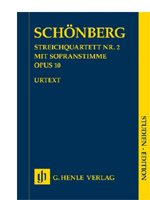Schoenberg, Arnold String Quartet No 2, op 10
Chamber Music Study Scores

-
Schoenberg, Arnold
String Quartet No 2, op 10 [with soprano, study score]
20th Century. This chamber music work, composed in 1907/08, marks a turning point not only in Sch”nberg's output, but also for the history of modern music in general. Major-minor tonality, obligatory for centuries, is increasingly abandoned over the fourmovements in favor of a free atonality. This break with music-historical tradition goes hand-in-hand with a further breach of convention; in the last two movements, Sch”nberg includes a solo soprano singing settings of two poems by Stefan George. With the transition to atonality, Sch”nberg opens the way to a new musical language which was to lead to twelve-tone music a little later. Without question, his second String Quartet represents a landmark in the history of music. The new Henle edition is edited by Sch”nberg specialist Ullrich Scheideler reflecting the latest state of research. The Henle Urtext edition publishes this modern classic in a new, generously laid out music setting. - the publisher -
- Category: Chamber Music Study Scores
- Item: 134762
- Grade/Level: Advanced
- Price: $23.95
-
(usually ships in 24 hours)
